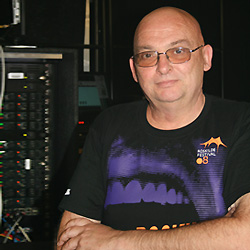
I see. I guess you must have seen some reduction in spectrum availability here in the UK, too, since the Channel 38 switchover?
Yes, that’s true, but I’ve always had this thing about putting the most amount of frequencies in the smallest possible space, so now it’s just a case of having to do that a lot more, as we’ve lost effectively 70 MHz worth of spectrum since the switchover.
Essentially, the more RF there is, the more efficient you have to try and be?
Exactly, and if you look at it, there’s more and more digital TV scattered around the place these days, so whatever we do now, it has to be squeezed into a smaller space. Every manufacturer says: “you can put this many frequencies in and you can do this and that,” but that’s based on ideal conditions and we don’t really work in ideal conditions. So what we have to do is play around and deal with it our way, building up a knowledge database through trial and error, really.
Are there any major advancements on the horizon in terms of RF technology, or anything you’d like to see change within the industry?
Everything’s progressing. If you look at digital wireless, Shure has a system out that’s particularly inexpensive and Sennheiser has a system out that is more expensive. Digital has its uses, but again, once we enter into that world, we have latency.
I’d love to be able to go digital on everything, but we’re already going through digital desks, which have latency, so until the latency becomes negligible, we’re always going to have to use the analog side of things. Even when I stand at a digital desk with a digital mic and speak into it, I can feel the delay in my in-ear monitors, so for a drummer trying to follow a click – well, you can imagine the potential issues.
You just did Robbie Williams’ new show at The O2, which was set “in the round” – does that require a different approach in terms of RF?
Yes it does. I had a chat with the monitor engineer and persuaded him that the best place for the in-ear antenna was right above the stage in the roof, and as it was they had a motion control station up there, so that’s where I put the racks. They needed someone to stay with them, so I would travel 30 meters up into the roof to go to work, and actually it worked really well; I didn’t have to use very high power and I didn’t have do anything particularly tricky.
But it’s that sort of thing that has to be considered: where do I put it? The antenna cables were 2 meters long so we could maximize the amount of RF that came out of the transmitter.
As RF engineers, that is our biggest thing: any bit of cable we put on, we get loss, even the good RG 213 cable loses power every three meters, effectively, so if you put a 10-meter cable on there, you’ve halved your power from 50 mw down to 25 mw, or 30 mw down to 15 mw. That’s why it was the best place for the antenna.
Do you ever just think “how can I make this simpler?”
Oh, all the time, but I haven’t come up with an answer yet! [laughs] In my job, I like to be able to tell people with confidence which way to go when they’re working with big systems, but you know, at the moment I’m just not sure.
There are a lot of things that are good in one respect and bad in another when you’re working in RF, and I’m still a great believer in “keep it simple, stupid” and taking it from there. But yes, maybe we can simplify the process somewhere along the line – that’d be nice, wouldn’t it? [smiles]
Paul Watson is the editor for Europe for Live Sound International and ProSoundWeb.
